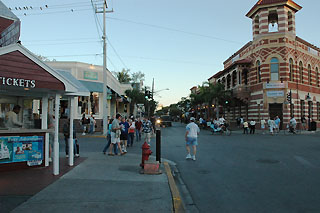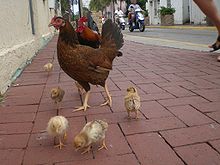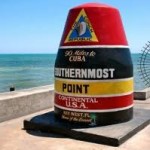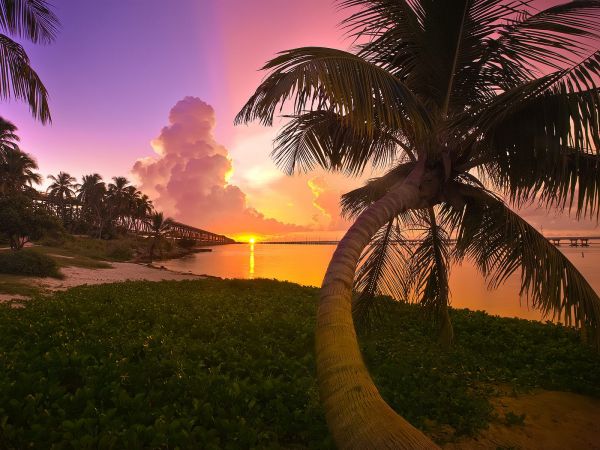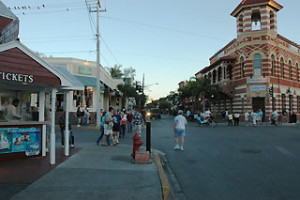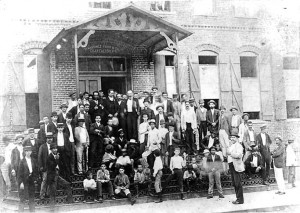WHEN KEY WEST, FLORIDA WAS CUBAN.
Key West is much closer to what is Havana to Miami. In 1890, Key West had a population of nearly 18,800, and was the largest and richest city in Florida. Currently half of the residents were said to be of Cuban origin, and knowledge of all Key West regularly had Cuban mayors, including the son of Carlos Manuel de Céspedes, the father of the Republic of Cuba, who was elected mayor in 1876. It is said that before 1760 and lived in Key West people born in Cuba.
There were times when the Florida depended on the Captaincy General of Havana. At that time, the capital of Cuba was, as a city, more and more important for cities like New York and Philadelphia. The English, in 1762, it occupied the island, they simply had to fill Havana. Spain, the following year, ceded to England all the Florida peninsula as long back, gives an idea of the importance attached to Madrid the capital of the Greater Antilles.
Key West was considered part of Florida. Hence, when Spain ceded the peninsula to England, was also considered given Key. But London barely paid any attention to the island, which continued to be used as occasional seating fishermen born in Cuba and other Caribbean islands. When America became independent citizens arrived at the site of the new nation, yet for years Washington did not exert any control over Key West and recognized him. Nor would any government.
It was perhaps this fact that motivated that in 1815 the Governor of Havana granted the territory of Cayo Juan Pablo Salas. The Creole clever short time retain the property. Growing presence of U.S. citizens in Florida and Chambers thought it would be best to sell the Cayo. He did. The trouble is that he did it twice. First, one John Strong, and then to John W. Simonton, who was quick to pass it to General John Guedes, former governor of South Carolina. It was then discovered the trap of John Paul Chambers. The matter went to court and Simonton won the disputed property. I had no more right than Strong, but more influence in Washington.
By then the U.S. government had decided to take action on the matter and recognize their rights to the Cayo. Indeed, the March 25, 1822, Lieutenant Matthew C. Perry, the Navy, landed in the territory, planted the flag of your country and proclaiming American sovereignty over Key West and also proceeded to rename it. He named the territory as Thompson’s Island, in honor of Smith Thompson, secretary of the Navy, and gave the port the name of Rodgers, to honor a war hero. None of the new names had roots. Key West, Key West, is its official name, although people of Spanish descent still calling Key West because, according to tradition, the first settlers found many remains of human skeletons on beaches.
You call one way or another, the southernmost of the U.S. locations, about three hours away from Miami, is a major tourist destination and enjoys the favor of travelers from all over the world. Several cruise lines make a stop there. Facilities for visitors are as numerous and widespread that you come to think that the Key is dedicated entirely to the entertainment industry. The restaurants and hotels, for all levels acquisitive, exceed all expectations. There are museums of treasures saved samples of terrible shipwrecks, and curio shops attract the attention of the traveler. Key West has a reputation of being, along with San Francisco and New Orleans, one of the most liberal cities in the United States, where the enthusiasm of its people and the cheerful and relaxed way of life invites a bohemian and relaxed stay.
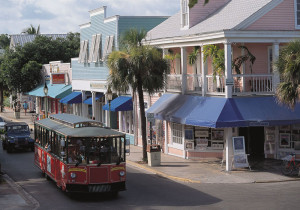
FLORIDA KEYS, KEY WEST — Stretching from the Atlantic Ocean to the Gulf of Mexico Duval Street is considered Òthe longest street in the United States” Galleries, shops, restaurants and bars make up the scenery on Key WestÕs main street. Photo by Len Kaufman/TDC.
Before the influx of Cubans moved by the war, Key West had suffered a series of fires that devastated much of its urban area. The Cubans were glued to the task of reconstruction and thanks to his efforts the Key acquired a new and prosperous image. In many buildings, the wood was replaced by red brick. And Cuban tiles were used on the decks. There are still some of those buildings as testimony to a time when Cubans both contributed to the economic and social aggrandizement of Key West and made the town an important place in Florida.
Roosters are a kind of sacred animal in Key West. They move most unlikely places and do virtually whatever they want. Gypsies are called roosters there. No one drives them away, and for several decades are controversial between proponents and those who want to eliminate them. There are also six fingers cats. Is of a particular gene, a characteristic of animals of that race arriving in the area from Boston. I saw these animals in the house of Ernest Hemingway. It is believed that these cats bring good luck.
The Cubans have been active in many of the then known 200 factories in Key West, producing 100 million cigars a year. The first cigar factory that existed in this town dates from 1831. That shows, scholars say, that there was communication and perhaps some kind of trade between Havana and Key West. These factories or small shops multiplied by the outbreak of the Ten Years War in 1868. Thousands of Cubans settled in Key West and then the Spanish language became a language of everyday use. Newspapers were founded for immigrants and bilingual schools emerged. In 1871 he opened the San Carlos Institute, named in honor of Cespedes, and four years later a son of the Father of the Nation was elected mayor of the town.
José Martí made several visits to seek recruits for the independence of Cuba from 1891 and founded the Cuban Revolutionary Party during his visits to Key West. José Martí arrives for the first time to Key West on Christmas Day 1891, more nourished and emigration, which never failed to put out the fire of independence in their altars, welcomes you with open arms. With bands and flags. A huge crowd came to the hotel it Duval. There, from his sickbed, lime friction between the new and old pines. Still persist in certain divisions Cayo, remnants of the politics of 68, and conflicts between aldamistas quesadistas. Marti joins board criteria and wills. Men who have spent years without speaking, they embrace in his presence. Write on the spot the foundations of the Cuban Revolutionary Party, and when he speaks in San Carlos, the old club of Cubans, his speech left no longer has the faith ciliciada of his speeches in recent years, but a glorious tone of certainty.
By the end of the nineteenth century battleship USS Maine sailed from Key West fateful visit to Havana, where he blew himself up, starting the Spanish-American War. The crew of the ship are buried in Key West, and marine research in the blast occurred at the Key West Customs House.
Pan American Airlines was founded in Key West originally to fly visitors to Havana in 1926.
John F. Kennedy always used the phrase “90 miles from Cuba” extensively in his speeches against Fidel Castro. Kennedy himself visited Key West a month after the resolution of the missile crisis in Cuba.
Before the Cuban revolution of 1959, there were regular ferry and air services between Key West and Havana.
Key West was flooded with refugees during the Mariel boatlift. Refugees continue to arrive on shore, at least on one occasion, especially in April 2003, flew hijacked airliners Cuban airlines at the airport from the city.
Key West has always been an important military post, as it lies on the northern edge of the deep water channel that connects the Atlantic and Gulf of Mexico (the southern edge 90 miles (140 km) away is Cuba) Straits of Florida. Because of this, Key West from the 1820s had been dubbed the “Gibraltar of the West”.
This small island is, in the words of cuban intellectual Jorge Manach, a piece of Cuban honorary land. Bone and marrow of the nation, as stated by Fina García Marruz. A place so linked with the emergence of Cuba as a nation that José Martí called “the fingertip of the Republic” or “Cayo dear.”
CUANDO KEY WEST, FLORIDA (CAYO HUESO), ERA CUBANO.
Key West está mucho más cerca de lo que es La Habana a Miami. En 1890, de Cayo Hueso tenía una población de casi 18.800, y fue la ciudad más grande y rica en la Florida. Actualmente la mitad de los residentes se les dice que es de origen cubano, y para conocimiento de todos Cayo Hueso regularmente tenía los alcaldes cubanos, entre ellos el hijo de Carlos Manuel de Céspedes, el padre de la República de Cuba, que fue elegido alcalde en 1876. Se dice que antes de 1760 vivía ya en Cayo Hueso gente nacida en Cuba
Hubo tiempos en que la Florida dependía de la Capitanía General de La Habana. En esa época, la capital de Cuba era, como ciudad, mayor y más importante que urbes como Nueva York y Filadelfia. Los ingleses, en 1762, no ocuparon la Isla; les bastó con ocupar La Habana. Que España, al año siguiente, cediera a Inglaterra toda la península de la Florida con tal de recuperarla, da una idea de la importancia que Madrid concedía a la capital de la Mayor de las Antillas.
Cayo Hueso era considerado parte de la Florida. De ahí que cuando España cedió esa península a Inglaterra, el Cayo también se consideró cedido. Pero Londres apenas le hizo caso al islote, que siguió siendo utilizado como asiento ocasional de pescadores nacidos en Cuba y en otras islas del Caribe. Cuando Estados Unidos logró su independencia arribaron al lugar ciudadanos de la nueva nación; aun así, durante años, Washington tampoco ejerció ningún control sobre Cayo Hueso ni lo reconoció. Tampoco lo haría gobierno alguno.
Fue quizá esa circunstancia la que motivó que en 1815 el Gobernador de La Habana otorgara el territorio del Cayo a Juan Pablo Salas. El avispado criollo retendría poco tiempo la propiedad. Crecía la presencia de ciudadanos norteamericanos en la Florida y Salas creyó que lo más conveniente sería vender el Cayo. Así lo hizo. Lo malo es que lo hizo dos veces. Primero, a un tal John Strong, y luego a John W. Simonton, que no demoró en traspasarla al general John Guedes, ex gobernador de Carolina del Sur. Fue entonces cuando se descubrió la trampa de Juan Pablo Salas. El asunto llegó a los tribunales y Simonton se alzó con la propiedad en disputa. No tenía más derecho que Strong, pero sí más influencias en Washington.
Ya para entonces el Gobierno norteamericano había decidido tomar cartas en el asunto y reconocer sus derechos sobre el Cayo. En efecto, el 25 de marzo de 1822, el teniente Matthew C. Perry, de la Marina de Guerra, desembarcaba en dicho territorio, plantaba la bandera de su país y proclamaba la soberanía norteamericana sobre Cayo Hueso y procedió asimismo a cambiarle el nombre. Bautizó el territorio como Thompson’s Island, en honor de Smith Thompson, secretario de Marina, y dio al puerto el nombre de Rodgers, en homenaje a un héroe de guerra. Ninguna de las nuevas denominaciones tuvo arraigo. Key West —Cayo Oeste— es su nombre oficial, aunque la gente de ascendencia española sigue llamándole Cayo Hueso porque, dice la tradición, los primeros colonizadores encontraron muchos restos de esqueletos humanos en sus playas.
Se le llame de una manera o de otra, la más meridional de las localidades norteamericanas, a unas tres horas de camino de Miami, es una ciudad turística por excelencia y goza del favor de viajeros de todas partes del mundo. Varias líneas de cruceros hacen escala allí. Las facilidades para el visitante son tan numerosas y extendidas que se llega a pensar que el Cayo está dedicado del todo a la industria del ocio. Sus restaurantes y hoteles, para todos los niveles adquisitivos, superan cualquier expectativa. Hay en sus museos muestras de tesoros salvados de terribles naufragios, y las tiendas de curiosidades atraen la atención del caminante. Tiene fama Cayo Hueso de ser, junto con San Francisco y Nueva Orleans, una de las urbes más liberales de los Estados Unidos, donde el entusiasmo de su gente y el paso alegre y descansado de la existencia convida a una estancia bohemia y relajada.
Antes de la llegada masiva de cubanos movidos por la guerra, Cayo Hueso había sufrido una serie de incendios que devastaron gran parte de su zona urbana. Los cubanos se pegaron a la tarea de reconstrucción y gracias a su esfuerzo el Cayo adquirió una imagen nueva y próspera. En muchas edificaciones, la madera se sustituyó por ladrillos rojos. Y tejas cubanas se emplearon en las cubiertas. Todavía se mantienen algunas de esas edificaciones como testimonio de una época en la que los cubanos tanto aportaron al engrandecimiento económico y social de Cayo Hueso e hicieron de la localidad un lugar preeminente en la Florida.

FLORIDA KEYS, KEY WEST — Stretching from the Atlantic Ocean to the Gulf of Mexico Duval Street is considered Òthe longest street in the United States” Galleries, shops, restaurants and bars make up the scenery on Key WestÕs main street. Photo by Len Kaufman/TDC.
Los gallos son una especie de animal sagrado en Cayo Hueso. Se mueven por los sitios más impensados y hacen virtualmente lo que les da la gana. Les llaman allá gallos gitanos. Nadie los ahuyenta, y desde hace varias décadas son motivo de controversia entre sus defensores y los que quieren eliminarlos. Hay también gatos de seis dedos. Es, por un gen determinado, una característica propia de animales de esa raza que llegaban a la localidad procedentes de Boston. Vi esos animales en la casa de Ernest Hemingway. Se considera que esos gatos traen buena suerte.
Los cubanos han participado activamente en gran parte de las conocidas 200 fábricas de entonces en Cayo Hueso, la producción de 100 millones de puros al año.
La primera fábrica de tabacos que existió en esa localidad data de 1831. Eso pone de manifiesto, afirman los estudiosos, que existía comunicación y quizá algún tipo de comercio entre el Cayo y La Habana. Esas fábricas o chinchales se multiplicaron al estallar la Guerra de los Diez Años, en 1868. Miles de cubanos se asentaron entonces en Cayo Hueso y el idioma español pasó a ser una lengua de uso diario. Se fundaron periódicos para los emigrados y surgieron escuelas bilingües. En 1871 abrió sus puertas el Instituto San Carlos, llamado así en honor de Céspedes, y cuatro años después un hijo del Padre de la Patria era electo alcalde de la villa.
José Martí hizo varias visitas a buscar reclutas para la independencia de Cuba a partir de 1891 y fundó el Partido Revolucionario Cubano durante sus visitas a Cayo Hueso. José Martí llega por primera vez a Cayo Hueso en la Navidad de 1891, y la más nutrida de las emigraciones, la que nunca dejó apagar el fuego de la independencia en sus altares, lo recibe con los brazos abiertos. Con bandas y banderas. Una multitud enorme lo acompaña hasta el hotel Duval. Allí, desde su lecho de enfermo, lima asperezas entre los pinos nuevos y los viejos. Perduran todavía en el Cayo ciertas disensiones, resabios de la política del 68, pugnas entre aldamistas y quesadistas. Martí junta criterios y aúna voluntades. Hombres que llevan años sin hablarse, se abrazan en su presencia. Escribe allí mismo las bases del Partido Revolucionario Cubano, y cuando habla en el San Carlos, el viejo club de los cubanos, su discurso ya no tiene el dejo de fe ciliciada de sus discursos de los últimos años, sino un acento de gloriosa certidumbre.
Para finales del siglo XIX el acorazado USS Maine zarpó de Cayo Hueso en su visita fatídica a La Habana, donde se inmoló, iniciando la Guerra Española-Americana. Los tripulantes de la nave están enterrados en Key West, y la investigación marina en la explosión se produjo en el Key West Casa de la Aduana.
Pan American Airlines fue fundada en Cayo Hueso, originalmente para volar a los visitantes a La Habana, en 1926.
John F. Kennedy siempre utilizaba la frase “a 90 millas de Cuba” ampliamente en sus discursos contra Fidel Castro. El propio Kennedy visitó Key West un mes después de la resolución de la crisis de los misiles de Cuba.
Antes de la revolución cubana de 1959, hubo regular de ferry y de los servicios aéreos entre Cayo Hueso y La Habana.
Cayo Hueso fue inundado con los refugiados durante el éxodo del Mariel. Los refugiados siguen llegando a tierra y, por lo menos en una ocasión, sobre todo en abril de 2003, voló aviones secuestrados las líneas aéreas cubanas en el aeropuerto de la ciudad.
Key West siempre fue un puesto militar importante, ya que se encuentra en el extremo norte del canal de aguas profundas que conecta el Atlántico y el Golfo de México (las del sur de borde a 90 millas (140 km) de distancia es Cuba) a través del Estrecho de la Florida. Debido a esto, Key West desde la década de 1820 había sido apodado como el “Gibraltar del Oeste”.
Esta pequeña isla es, al decir de Jorge Mañach, un pedazo honorario de la tierra cubana. Hueso y médula de la patria, como afirma Fina García Marruz. Un lugar tan enlazado con el surgimiento de Cuba como nación que José Martí le llamó «la yema de la República» al «Cayo querido».
Wiki/CiroBianchiRoss/InternetPhotos/TheCubanHistory.com
The Cuban History, Hollywood.
Arnoldo Varona, Editor



 WHEN KEY WEST, FLORIDA was Cuban. *** CUANDO KEY WEST, FLORIDA (Cayo Hueso) era Cubano.
WHEN KEY WEST, FLORIDA was Cuban. *** CUANDO KEY WEST, FLORIDA (Cayo Hueso) era Cubano.